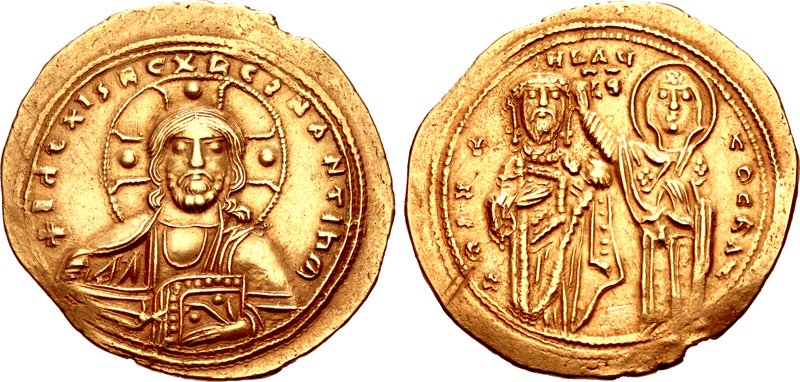Michael VI on:
[Wikipedia]
[Google]
[Amazon]
Michael VI Bringas (; died ), also called Stratiotikos (, "the military one, the warlike") and the Old (, ''Geron''), reigned as
 Apparently a relative of the powerful courtier Joseph Bringas (influential during the reign of
Apparently a relative of the powerful courtier Joseph Bringas (influential during the reign of
Byzantine emperor
The foundation of Constantinople in 330 AD marks the conventional start of the Eastern Roman Empire, which Fall of Constantinople, fell to the Ottoman Empire in 1453 AD. Only the emperors who were recognized as legitimate rulers and exercised s ...
from 1056 to 1057.
Career
 Apparently a relative of the powerful courtier Joseph Bringas (influential during the reign of
Apparently a relative of the powerful courtier Joseph Bringas (influential during the reign of Romanos II
Romanos II (; 938 – 15 March 963) was Byzantine Emperor from 959 to 963. He succeeded his father Constantine VII at the age of twenty-one and died suddenly and mysteriously four years later. His wife Theophano helped their sons Basil II ...
), Michael Bringas was an elderly patrician (hence the nickname "Geron") and a member of the court bureaucracy when he ascended to the throne. He had formerly served as a military finance minister ('' logothetes tou stratiotikou'', hence the epithet ''Stratiotikos''). Michael Bringas was chosen for his pliability by the empress Theodora as her successor shortly before her death on 31 August 1056. The appointment had been secured through the influence of Leo Paraspondylos, Theodora's most trusted adviser, who remained chief minister.
Although Michael managed to survive a conspiracy organized by Theodosios, a nephew of the former emperor Constantine IX Monomachos, he was faced with the disaffection of the military aristocracy. His most costly error was to ignore the perceived rights of the general Nikephoros Bryennios, who had been demoted and reduced to poverty after falling out with the Empress Theodora; Michael restored Bryennios's military rank, but not his confiscated wealth and estates.Finlay, p. 533 Michael compounded his error by rebuffing Bryennios after he had already ordered the restored general to lead a division of 3,000 men to reinforce the army in Cappadocia
Cappadocia (; , from ) is a historical region in Central Anatolia region, Turkey. It is largely in the provinces of Nevşehir, Kayseri, Aksaray, Kırşehir, Sivas and Niğde. Today, the touristic Cappadocia Region is located in Nevşehir ...
. From here Bryennios began plotting to overthrow Michael VI, and it was his capture that precipitated the military nobility to rally around the general Isaac Komnenos, who was proclaimed emperor in Paphlagonia
Paphlagonia (; , modern translit. ''Paflagonía''; ) was an ancient region on the Black Sea coast of north-central Anatolia, situated between Bithynia to the west and Pontus (region), Pontus to the east, and separated from Phrygia (later, Galatia ...
on 8 June 1057.
Soon after, the government's army was routed at the Battle of Petroe (20 August 1057) near Nicaea
Nicaea (also spelled Nicæa or Nicea, ; ), also known as Nikaia (, Attic: , Koine: ), was an ancient Greek city in the north-western Anatolian region of Bithynia. It was the site of the First and Second Councils of Nicaea (the first and seve ...
, and Isaac Komnenos advanced on Constantinople
Constantinople (#Names of Constantinople, see other names) was a historical city located on the Bosporus that served as the capital of the Roman Empire, Roman, Byzantine Empire, Byzantine, Latin Empire, Latin, and Ottoman Empire, Ottoman empire ...
. Michael VI attempted to negotiate with the rebels through the famous courtier Michael Psellos
Michael Psellos or Psellus (, ) was a Byzantine Greeks, Byzantine Greek monk, savant, writer, philosopher, imperial courtier, historian and music theorist. He was born in 1017 or 1018, and is believed to have died in 1078, although it has also b ...
, offering to adopt Isaac as his son and to grant him the title of ''kaisar'' (caesar
Gaius Julius Caesar (12 or 13 July 100 BC – 15 March 44 BC) was a Roman general and statesman. A member of the First Triumvirate, Caesar led the Roman armies in the Gallic Wars before defeating his political rival Pompey in a civil war. He ...
), but his proposals were publicly rejected. Privately Isaac showed himself more open to negotiation, and he was promised the status of co-emperor. However, during the course of these secret negotiations, a riot in favor of Isaac broke out in Constantinople. Patriarch Michael Keroularios convinced Michael VI to abdicate in Isaac's favor on 30 August 1057. The emperor duly followed the patriarch's advice and became a monk. He retired to his private home and died there shortly thereafter.
Sources
Primary sources
*Michael Psellus
Michael Psellos or Psellus (, ) was a Byzantine Greek monk, savant, writer, philosopher, imperial courtier, historian and music theorist. He was born in 1017 or 1018, and is believed to have died in 1078, although it has also been maintained tha ...
, ''Chronographia''.
*
Secondary sources
* * * * *See also
*List of Byzantine emperors
The foundation of Constantinople in 330 AD marks the conventional start of the Eastern Roman Empire, which Fall of Constantinople, fell to the Ottoman Empire in 1453 AD. Only the emperors who were recognized as legitimate rulers and exercised s ...
References
{{DEFAULTSORT:Michael 06 Bringas 11th-century Byzantine emperors Byzantine emperors who abdicated Eastern Orthodox monks Year of birth unknown Place of birth unknown 1050s deaths 1050s in the Byzantine Empire Logothetai tou stratiotikou